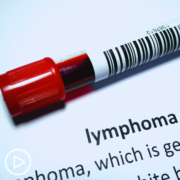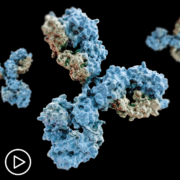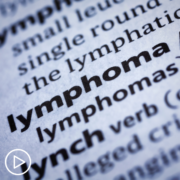Understanding Follicular Lymphoma Disease Progression Symptoms and Monitoring
Understanding Follicular Lymphoma Disease Progression Symptoms and Monitoring from Patient Empowerment Network on Vimeo.
How are follicular lymphoma symptoms and disease progression monitored? Expert Dr. Sameh Gaballa explains follicular lymphoma disease transformation, symptoms to be on the lookout for, and frequency of monitoring during watch and wait.
Dr. Sameh Gaballa is a hematologist/oncologist specializing in treating lymphoid malignancies from Moffitt Cancer Center. Learn more about Dr. Gaballa.
See More from START HERE Follicular Lymphoma
Related Resources:

Follicular Lymphoma Disease Transformation and Secondary Cancer Risk |

Relapsed/Refractory Follicular Lymphoma Treatments and Bispecific Antibodies |

|
Transcript:
Lisa Hatfield:
Although follicular lymphoma is a slow-growing cancer, can you speak to the signs that the disease is progressing in the body, what signs that patients might want to look out for?
Dr. Sameh Gaballa:
Yeah, absolutely. So, typically we educate the patients to there are some red flags to look out for, not just for progression,but also for another condition called disease transformation. So, follicular lymphoma does have a, there is a possibility that it can transform from a slow-growing lymphoma to an aggressive lymphoma. Now, this happens at a rate of about maybe 2 to 3 percent per year, but it’s a cumulative risk, so meaning if a patient lives many, many decades, their lifetime risk can be up to as high as 20, 25 percent, 30 percent, depending on the different literature, so there is a chance that these slow-growing lymphomas can transform to an aggressive lymphoma.
And when they do know this, there’s no watch and wait for transformed disease. It has to be treated with chemo immunotherapy because the goal of treatment then is to try to get rid of the aggressive component. What are the signs and symptoms to suggest that you might have transformed disease? This is not something that the patient would typically need to look out for. I tell my patients that, “You don’t need to see, do I have transformed disease or not. This is going to come, and you’re going to know when you have transformed disease. Extreme fatigue, drenching night sweats, the fever sometimes that are not going away.”
The patient might have pain if the lymph node is pressing on some important structure. They may have loss of appetite, loss of weight. So again, something that dramatically happens quickly over a few weeks of time. So if the patient feels sick for one reason or another and they’re not getting better, it can all happen within a few weeks’ time frame. This is the time to get checked early on and go see your oncologist, because then we might need to investigate if there is any potential for transformation. So that’s issue number one.
Issue number two is, which is the much more common scenario, which is the follicular lymphoma is slowly progressing. How would you know? I mean, if you notice a lymph node that in your neck or under the armpits or the groin areas, if they’re growing, then that needs to be evaluated. I mean the patients should expect that those will be growing, they will grow. But they grow over months and years. They don’t grow over weeks.
So anytime you kind of are unsure, if you feel that it’s growing faster than usual, this is, again, something to look out for. And then the B symptoms that I mentioned. So like the sweats, the fevers, the weight, loss of weight, loss of appetite, these are also sometimes things to look out for. Not necessarily, they don’t always mean that it’s transformed disease. It can also be that the follicular lymphoma is also progressing and might need to be treated as well.
Lisa Hatfield:
And then just a quick follow-up to that question. So a patient is watching out for these red flags, but are they going through any kind of regular monitoring in your office? Are you meeting with them on a regular basis? And how frequent might that be for a follicular lymphoma patient who’s watching and waiting?
Dr. Sameh Gaballa:
Yeah. So how does watch and wait look? So, and I tell patients always watch and wait does not mean ignore. Watch and wait means that we’re monitoring the disease, we’re looking at it. How do we do that? So typically we would see the patient maybe every three to six months. And then depending on how do we, when we get a sense or tempo of how their disease is progressing, then we’ll know how often we need to see them. I’ve had, I still have patients where I’m seeing them every three months. And I also have some patients where the disease has been stable for years, I only see them once a year. In terms of imaging, that’s also sometimes an area of controversy. Typically, initially for the first maybe year or two years, I do like a scan, like a CT scan every six months, just to get a sense of how quick or how slow the disease is progressing. If there’s absolutely no change at all, then sometimes we either don’t do scans and just go by the patient’s symptoms and blood work and physical exam, or we do maybe once a year scan but not more than that. So this is how we would monitor the patients in a watch-and-wait approach.
Share Your Feedback:
Create your own user feedback survey









